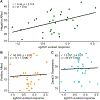Resting fMRI-guided TMS evokes subgenual anterior cingulate response in depression
- PMID: 39638081
- PMCID: PMC11887861
- DOI: 10.1016/j.neuroimage.2024.120963
Resting fMRI-guided TMS evokes subgenual anterior cingulate response in depression
Abstract
Background: Depression alleviation following treatment with repetitive transcranial magnetic stimulation (rTMS) tends to be more effective when TMS is targeted to cortical areas with high (negative) resting state functional connectivity (rsFC) with the subgenual anterior cingulate cortex (sgACC). However, the relationship between sgACC-cortex rsFC and the TMS-evoked response in the sgACC is still being explored and has not yet been established in depressed patients.
Objectives: In this study, we investigated the relationship between sgACC-cortical (site of stimulation) rsFC and induced evoked responses in the sgACC in healthy controls and depressed patients.
Methods: For each participant (N = 115, 34 depressed patients), a peak rsFC cortical 'hotspot' for the sgACC and control targets were identified at baseline. Single pulses of TMS interleaved with fMRI readouts were administered to these targets to evoke downstream fMRI blood-oxygen-level-dependent (BOLD) responses in the sgACC. Generalized estimating equations were used to investigate the association between TMS-evoked BOLD responses in the sgACC and rsFC between the stimulation site and the sgACC.
Results: Stimulations over cortical sites with high rsFC to the sgACC were effective in modulating activity in the sgACC in both healthy controls and depressed patients. Moreover, we found that in depressed patients, sgACC rsFC at the site of stimulation was associated with the induced evoked response amplitude in the sgACC: stronger positive rsFC values leading to stronger evoked responses in the sgACC.
Conclusions: rsFC-based targeting is a viable strategy to causally modulate the sgACC. Assuming an anti-depressive mechanism working through modulation of the sgACC, the field's exclusive focus on sites anticorrelated with the sgACC for treating depression should be broadened to explore positively-connected sites.
Keywords: Depression; Functional connectivity; TMS; fMRI; sgACC.
Copyright © 2024. Published by Elsevier Inc.
Conflict of interest statement
Declaration of competing interest The authors declare that they have no known competing financial interests or personal relationships that could have appeared to influence the work reported in this paper.
Figures




References
-
- Avants BB, Tustison N, Song G, 2009. Advanced normalization tools (ANTS). Insight. J. 2, 1–35.
-
- Baeken C, Marinazzo D, Everaert H, Wu GR, Van Hove C, Audenaert K, Goethals I, De Vos F, Peremans K, De Raedt R, 2015. The impact of accelerated HF-rTMS on the subgenual anterior cingulate cortex in refractory unipolar major depression: insights from 18FDG PET brain imaging. Brain Stimul. 8, 808–815. - PubMed
-
- Cash RF, Zalesky A, Thomson RH, Tian Y, Cocchi L, Fitzgerald PB, 2019. Subgenual functional connectivity predicts antidepressant treatment response to transcranial magnetic stimulation: independent validation and evaluation of personalization. Biol. Psychiatry 86, e5–e7. - PubMed
-
- Chang K-Y, Tik M, Mizutani-Tiebel Y, Schuler A-L, Taylor P, Campana M, Vogelmann U, Huber B, Dechantsreiter E, Thielscher A, 2024a. Neural response during prefrontal theta burst stimulation: interleaved TMS-fMRI of full iTBS protocols. Neuroimage 291, 120596. - PubMed
MeSH terms
Grants and funding
LinkOut - more resources
Full Text Sources
Medical

